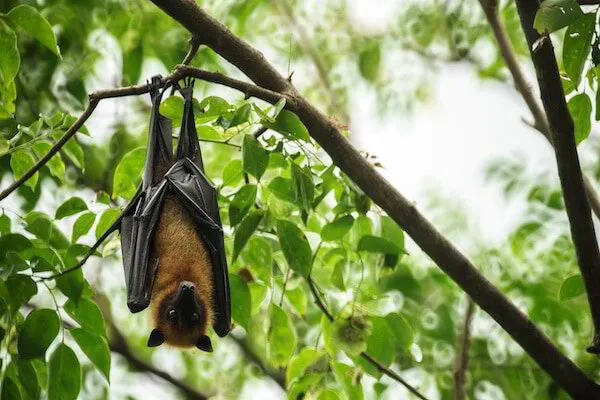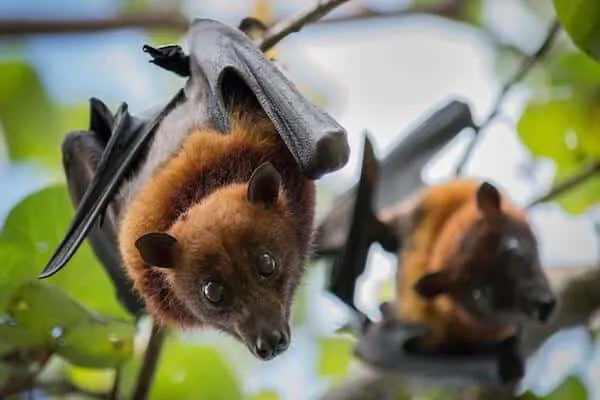What are Bats?
Bats are fascinating mammals renowned for their unique features, such as distinctive wing structures, echolocation abilities, and diverse species characteristics. They exhibit remarkable adaptability, thriving in various environments and habitats, from natural landscapes to urban settings. While they play a crucial role in pest control by consuming vast quantities of insects, some species also seek shelter in human-made structures.
Bats are adept at navigating the night skies in search of their primary food source—insects. Their nocturnal lifestyle and echolocation skills make them efficient hunters, contributing to the balance of insect populations in the ecosystem. In addition to their foraging prowess, bats exhibit social behaviors, often roosting in colonies and creating intricate habitats within caves, trees, or man-made structures.
As key contributors to pollination and seed dispersal, bats play a vital role in maintaining the health and biodiversity of ecosystems. Their adaptability and resourcefulness underscore their significance in ecological processes, making them a valuable component of the natural world. Despite their vital contributions, some bat species may inadvertently find their way into homes, prompting the need for humane and professional solutions to ensure both their preservation and human well-being.
Are Bats dangerous?
When living outside and away from people, bats and their feeding habits are helpful. However, when these flying mammals decide to nest or roost near or on our homes, they become less useful and more harmful.
Bats carry and transmit a variety of diseases to people and our pets, including rabies.
On their bodies live a variety of parasites, including ticks, fleas, and bat bugs that they introduce onto properties and into our homes.
In their feces is a fungus called Histoplasma capsulatum, which can cause severe health problems and lung disease in people.
Their presence makes people uncomfortable and unable to enjoy their outdoor space. Trying to enjoy an evening outside is difficult when you see bats darting around your yard and head.
Why do I have a Bat problem?
Bats live outside and will take the opportunity to live on any property that is offering them plenty of insects to feed on and areas to shelter. Bats tend to be most problematic on properties that have or are located near areas of water (ponds, lakes, marshes, pools, fountains, bird baths) because they tend to also have large populations of insects near them.
Bats sometimes enter into our homes, seeking a quiet place to rest during the day. They often enter indoors through open chimneys, openings along the roofline, through damaged roof shingles, through vents, open windows, or doors. It is important to know that bats only need a space that is between ¼ and ½ of an inch to gain access.
Where will I find Bats?
Bats live outside, choosing to roost or nest in dark areas that provide ample shelter. Caves, spaces between rocks, tree cavities, roof eaves, or spaces under bridges are common areas where bat colonies will congregate. Bats also like to roost in rafters found in warehouses, barns, and other large indoor spaces.
Areas inside of our homes that provide bats with the protection they need include attics, chimneys, crawlspaces, and wall voids. Bats are nocturnal. They hunt at night and rest during the daylight hours. They are very active right at dusk when many insects, including mosquitoes, are also active.
How do I get rid of Bats?
Getting rid of bats from your yard, home, or business is best left up to a professional. The professionals here at Amco Pest Solutions will provide you with the year-round solutions needed to get rid of bats and prevent them from returning. Whether you are looking to get rid of a current bat infestation or avoid future problems with them, our family owned and operated company is here to help.
Our professionals are committed to providing the pest control services needed to help home and business owners keep their properties free of bats and other common pests. Amco Pest Solutions offers residential pest control and commercial pest control services throughout New Jersey, the five boroughs of New York, and South Florida. Reach out today to learn more about our effective bat control solutions!
Discover our control prevention services for more information.
How can I prevent Bats in the future?
Sealing Entry Points
Identify and seal any holes or gaps along the roofline of your home. Bats can exploit even small openings to gain access to attics or other secluded spaces. Utilize appropriate materials to ensure a secure seal, preventing bats from entering.
Chimney Caps Installation
Safeguard your chimneys by installing tight-fitting caps. Chimneys without proper caps can become attractive roosting spots for bats. Caps not only deter bats but also serve as barriers against other wildlife, debris, and adverse weather conditions.
Observation at Dusk
Determine the presence of bats by observing their activity at dusk. Bats are nocturnal creatures, and their flight patterns during this time can indicate whether they are roosting in or around your house. Identifying their flight paths helps in assessing potential roosting sites.
Secure Vent Covers
Ensure that vents leading into attic spaces are equipped with secure mesh covers. Bats may exploit vulnerable vents as entry points. These covers allow proper ventilation while preventing bats from gaining access to indoor areas.
Remove Standing Water Sources
Address the attraction of insects, a primary food source for bats, by eliminating areas of standing water on your property. Stagnant water sources can harbor insects, creating an enticing environment for bats. Mitigating these water sources contributes to reducing the bat-attracting insect population.
Strategic Bat House Placement
Draw bats away from your home by strategically placing bat houses along the perimeter of your property. Bat houses provide alternative roosting options, encouraging bats to establish colonies in designated areas away from your residence. Properly designed bat houses mimic natural roosting environments, making them attractive to bats.
Bats Decoded: Quick Insights with Amco Pest Solution
Join us for a speedy exploration into the world of bats! Unravel the habits, risks, and effective solutions to keep these nocturnal visitors at bay. Get quick tips on identification and proactive measures. Watch now for rapid insights into dealing with bats with Amco Pest Solutions!
Discover The World Of Bats
Explore and learn about the ecology, diversity, and mystery of bats .
We offer humane bat removal services, ensuring safe relocation of bats while securing homes against re-entry, adhering to wildlife conservation standards.
Understanding bat behavior and the ecological benefits they provide is crucial for respectful and effective management of bat populations in and around properties.
Key prevention strategies include inspecting for and sealing entry points, and creating alternative habitats like bat houses to divert them from your home.
What are Bats?
Bats are fascinating mammals renowned for their unique features, such as distinctive wing structures, echolocation abilities, and diverse species characteristics. They exhibit remarkable adaptability, thriving in various environments and habitats, from natural landscapes to urban settings. While they play a crucial role in pest control by consuming vast quantities of insects, some species also seek shelter in human-made structures.
Bats are adept at navigating the night skies in search of their primary food source—insects. Their nocturnal lifestyle and echolocation skills make them efficient hunters, contributing to the balance of insect populations in the ecosystem. In addition to their foraging prowess, bats exhibit social behaviors, often roosting in colonies and creating intricate habitats within caves, trees, or man-made structures.
As key contributors to pollination and seed dispersal, bats play a vital role in maintaining the health and biodiversity of ecosystems. Their adaptability and resourcefulness underscore their significance in ecological processes, making them a valuable component of the natural world. Despite their vital contributions, some bat species may inadvertently find their way into homes, prompting the need for humane and professional solutions to ensure both their preservation and human well-being.
Are bats dangerous?
When living outside and away from people, bats and their feeding habits are helpful. However, when these flying mammals decide to nest or roost near or on our homes, they become less useful and more harmful.
Bats carry and transmit a variety of diseases to people and our pets, including rabies.
On their bodies live a variety of parasites, including ticks, fleas, and bat bugs that they introduce onto properties and into our homes.
In their feces is a fungus called Histoplasma capsulatum, which can cause severe health problems and lung disease in people.
Their presence makes people uncomfortable and unable to enjoy their outdoor space. Trying to enjoy an evening outside is difficult when you see bats darting around your yard and head.
Why do I have a bat problem?
Bats live outside and will take the opportunity to live on any property that is offering them plenty of insects to feed on and areas to shelter. Bats tend to be most problematic on properties that have or are located near areas of water (ponds, lakes, marshes, pools, fountains, bird baths) because they tend to also have large populations of insects near them.
Bats sometimes enter into our homes, seeking a quiet place to rest during the day. They often enter indoors through open chimneys, openings along the roofline, through damaged roof shingles, through vents, open windows, or doors. It is important to know that bats only need a space that is between ¼ and ½ of an inch to gain access.
Where will I find Bats?
Bats live outside, choosing to roost or nest in dark areas that provide ample shelter. Caves, spaces between rocks, tree cavities, roof eaves, or spaces under bridges are common areas where bat colonies will congregate. Bats also like to roost in rafters found in warehouses, barns, and other large indoor spaces.
Areas inside of our homes that provide bats with the protection they need include attics, chimneys, crawlspaces, and wall voids. Bats are nocturnal. They hunt at night and rest during the daylight hours. They are very active right at dusk when many insects, including mosquitoes, are also active.
How do I get rid of Bats?
Getting rid of bats from your yard, home, or business is best left up to a professional. The professionals here at Amco Pest Solutions will provide you with the year-round solutions needed to get rid of bats and prevent them from returning. Whether you are looking to get rid of a current bat infestation or avoid future problems with them, our family owned and operated company is here to help.
Our professionals are committed to providing the pest control services needed to help home and business owners keep their properties free of bats and other common pests. Amco Pest Solutions offers residential pest control and commercial pest control services throughout New Jersey, the five boroughs of New York, and South Florida. Reach out today to learn more about our effective bat control solutions!
Bat Behavior and Adaptation
Bats are the only mammals capable of sustained flight, which is a key adaptation allowing them to access a wide range of food sources, from insects to fruits. Their echolocation ability enables them to navigate and hunt in complete darkness, showcasing remarkable adaptations to nocturnal life. Bats play critical roles in ecosystems, including pollination, seed dispersal, and controlling insect populations.
Lifecycle and Reproduction
Bats have a unique reproductive cycle, often giving birth to a single pup each year, which increases the importance of each offspring's survival. Mothers invest significant care, with some species forming maternity colonies for communal rearing. This low reproductive rate makes bat populations vulnerable to disturbances, highlighting the need for conservation efforts to support their lifecycle and habitat requirements.
Bats and Their Role in Ecosystems
Bats significantly impact ecosystems through pollination, seed dispersal, and insect population control. By consuming vast amounts of insects, they reduce the need for pesticides in agriculture, benefiting human economies and health. Their roles in pollinating flowers and spreading seeds support forest regeneration and biodiversity, underscoring bats' importance in maintaining healthy ecosystems.
Managing Bat Populations
Managing bat populations involves conservation efforts that protect their natural habitats and roosting sites. Encouraging the presence of bats through the installation of bat houses can aid in controlling insect populations naturally. Protecting bats requires minimizing disturbances to their habitats, addressing threats like white-nose syndrome, and fostering a better understanding of their ecological benefits to ensure their survival and coexistence with humans.
How can I prevent Bats in the future?
Sealing Entry Points
Identify and seal any holes or gaps along the roofline of your home. Bats can exploit even small openings to gain access to attics or other secluded spaces. Utilize appropriate materials to ensure a secure seal, preventing bats from entering.
Chimney Caps Installation
Safeguard your chimneys by installing tight-fitting caps. Chimneys without proper caps can become attractive roosting spots for bats. Caps not only deter bats but also serve as barriers against other wildlife, debris, and adverse weather conditions.
Observation at Dusk
Determine the presence of bats by observing their activity at dusk. Bats are nocturnal creatures, and their flight patterns during this time can indicate whether they are roosting in or around your house. Identifying their flight paths helps in assessing potential roosting sites.
Secure Vent Covers
Ensure that vents leading into attic spaces are equipped with secure mesh covers. Bats may exploit vulnerable vents as entry points. These covers allow proper ventilation while preventing bats from gaining access to indoor areas.
Remove Standing Water Sources
Address the attraction of insects, a primary food source for bats, by eliminating areas of standing water on your property. Stagnant water sources can harbor insects, creating an enticing environment for bats. Mitigating these water sources contributes to reducing the bat-attracting insect population.
Strategic Bat House Placement
Draw bats away from your home by strategically placing bat houses along the perimeter of your property. Bat houses provide alternative roosting options, encouraging bats to establish colonies in designated areas away from your residence. Properly designed bat houses mimic natural roosting environments, making them attractive to bats.
Discover More Pests & Rodents Below!
Bats Decoded: Quick Insights with Amco Pest Solution
Join us for a speedy exploration into the world of bats! Unravel the habits, risks, and effective solutions to keep these nocturnal visitors at bay. Get quick tips on identification and proactive measures. Watch now for rapid insights into dealing with bats with Amco Pest Solutions!




